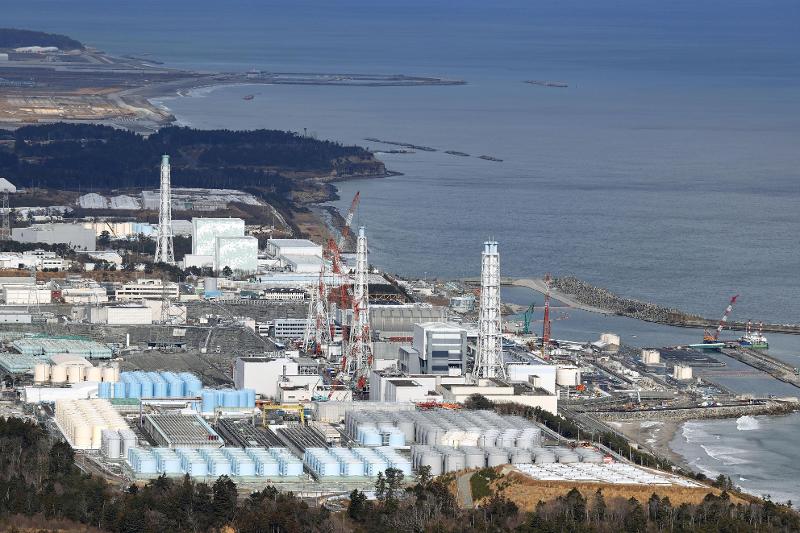-
 Korea.net's 24-hour YouTube channel
Korea.net's 24-hour YouTube channel- NEWS FOCUS
- ABOUT KOREA
- EVENTS
- RESOURCES
- GOVERNMENT
- ABOUT US

This photo of the Fukushima nuclear power plant in Japan was taken in January 2021. (Yonhap News)
The Japanese government on April 13 decided to release contaminated water stored at the No. 1 reactor of the Fukushima nuclear power plant into the sea. Tokyo's move not only incited strong opposition from the international community but also from the Japanese public. The following is a Korea.net Q&A on the proposed dumping with assistance from Yasuro Kawai, a member of the Working Group on Nuclear Regulation of Japan's Citizens' Commission on Nuclear Energy.
Edited by Kim Eun-young
1. Why does the Japanese government insist on releasing the contaminated water into the sea?
The Japanese government decided to dump the nuclear-contaminated water into the sea because the tank installed to store the water will run out of space in 2022. Though disposing of the polluted water can be done in many other ways, Tokyo opted for the cheapest option of dumping it into the ocean.
2. Instead of dumping into the sea, what are the other options?
They are either storing it in a large and strong tank for crude oil or using mortar solidification. The first proposed method is to store the contaminated water in a crude oil storage tank for a long time. Given that the half-life of tritium is 12.3 years, storing tritium for 120 years will reduce its level to 1/1,000th.
The other option is mortar solidification, a method in which cement and sand are added to the polluted water inside a concrete tank. This approach was used to handle contaminated water at nuclear facilities in the Savannah River of the U.S. The method enables the semi-permanent removal of the threat of radioactive leakage in the sea and uses existing construction technology. The quantity of radioactive materials declines as they approach their half-life, which sufficiently secures safety even if such materials deteriorate. Storage capacity, however, is reduced 25% because sand and cement must be mixed with the radioactive materials. This is possible if vacant land north of Tokyo Electric Power Company Holdings or other storage facilities for decontaminated waste are used.
3. How can Japan be prevented from releasing the water?
Dumping the contaminated water into the sea is a deliberate act by the Japanese government that threatens the planet's environment. Japan must never be allowed to do this, as it would violate the country's obligations under international maritime law and cause Japan to lose international credibility at the same time. The Korean government is considering various responses like filing a suit with the International Tribunal for the Law of the Sea, but there is no clear solution at this stage. To get the Japanese government to retract its decision, the people of both Korea and Japan must join forces to deliver a united voice in a cool and objective manner and the international society must pressure Tokyo.
4. Why does the Japanese government use the term "treated water" instead of "polluted water?"
Its choice of words seeks to justify its planned dumping. The Japanese government apparently wants to imply that the water's release is not problematic because it is not "contaminated." Yet what it calls "treated water" is contaminated radioactive water purified through the advanced liquid processing system (ALPS). When the 2011 earthquake hit eastern Japan, Fukushima's No. 1 reactor exploded and nuclear fuel inside the No. 3 reactor melted. All water at the Fukushima facility is thus "contaminated radioactive water," ranging from that used to cool the facility to rain seeping into the cracks of the reactor building and underground water.
5. Can ALPS filter out all radioactive materials?
No, it cannot filter tritium. The Japanese government aims to remove radioactive materials except tritium under regulatory standards for discharge. But 70% of the contaminated water contains radioactive substances such as cesium, strontium and iodine at levels that exceed regulatory standards.
6. When will the contaminated water be released into the sea?
As of April 15, the volume of the polluted water is an estimated 1.26 million tons. The tritium level within the water exceeds 860 trillion becquerel (Bq) (Bq is the unit of radiation produced per second), with an average concentration of approximately 700,000 Bq per liter. The Japanese government plans to release the polluted water over a 30–year period by reducing the annual release quantity to less than 22 trillion Bq and diluting the concentration level to under 1,500 Bq/L. As the volume of polluted water keeps increasing, the release period will be longer than planned. Before the 2011 earthquake, Japan released into the sea every year an estimated 2 trillion Bq of tritium. Based on arithmetic calculations, a volume of contaminated water that was supposed to have been released over 400 years will be dumped in just 30.
7. How does tritium affect the human body?
When it enters the human body, tritium emits radioactivity and transforms into helium, having the potential to cause bodily harm through gene modifications or the killing of cells. For example, reports say people who live near heavy-water reactors in Canada, where tritium levels are high, display higher rates of leukemia, miscarriage, Down's syndrome and neonatal heart disease.
Translated by Korea.net staff writer Yoon Sojung
Most popular
- First hearing-impaired K-pop act hopes for 'barrier-free world'
- Event 'K-Beauty Hang Out' draws hundreds in Philippines
- 'Mad Max' director impressed by 'cinema-literate' Korean viewers
- Ceremony in Seoul inducts 2,641 content creators of Korean culture
- Romanian presidential couple visits national cemetery













